Historical background
- 1. Kings and politics
- 2. The ‘‘three kingdoms’’
- 3. Country and city
- 4. International relations
- 5. The economy
The Chronology relates the historical events to the development of cities.
1. Kings and politics
a. From the Stuarts to the Georgian period
The last monarch of the Stuart dynasty, Queen Anne, died in 1714 without an heir. She was succeeded by a distant cousin, George of Hanover, the great-grandson of the first Stuart king (James I, who reigned 1603-1625) whose daughter had married a German prince in 1613. This first king of the new Hanover dynasty reigned under the name of George I (1714-1727); his sucessors were also named George – his son George II (reigned 1727-60), the latter’s grandson George III (reigned 1760-1820) followed by his son George IV (reigned 1820-30) – and thus the period was named ‘’the Georgian period’’.
b. Whigs and Tories
George I spoke very little English and remained Elector of Hanover as well, so that he did not take a very active role in English politics. Ministers and Parliament took on an increased role, which contributed to the development of a constitutional system. The ‘’two-party system’’ appeared: politics was dominated by the ‘’Whig’’ party which was in favour of such a regime giving ample powers to Parliament, the ‘’Tory’’ party in favour of stronger royal power being less influential. The Whig party took the name of ‘’Liberal Party’’ in the 19th century, the Tory party became the ‘’Conservative Party’’ though the word ‘’Tory’’ is still used informally – this evolution took place after the electoral reform of 1832 (see below).
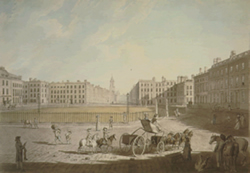
- Hanover Square
- The urban development thus reveals the underlying politics of the period if you understand the meaning of street names- which still exist. Taking a walk in the streets of cities is taking a walk through the politics of the past. In the Georgian Cities website, connect the chronology with the pages on cities.
[click on the picture to enlarge it].
The powerful Whig families showed their allegiance to the Hanover dynasty, which allowed them to rule the country, by giving names such as ‘’Hanover Square’’ to the areas of London developed then.
References to such places in novels should be understood as allusions to those social and political groups.
c. The two houses of Parliament : they were composed of MPs (members of Parliament)
- The House of Lords was hereditary. It was composed of members of the peerage, holding titles ranging from baron to duke, mostly landlords of vast country estates and sometimes city estates (see below’’Country and city estates’’).
- The House of Commons was elected, and the rules had been fixed in the Middle Ages: in the country, those who were entitled to vote were those who owned landed property above a certain value, and in town, householders having the right to vote were determined by local customs. So that the electorate – about 10% of the adult male population – was composed of the most powerful or richest ‘’commoners’’ (= those who were not noblemen, the nobility being in the House of Lords – the younger sons of the nobility counted as commoners and could be returned to the House of Commons). The vote was open ; secret ballot dates from the 19th century . See below ‘’The electoral system’’.
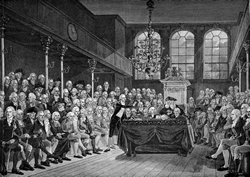
- William Pitt the Younger addressing the House of Commons
- William Pitt the Younger addressing the House of Commons, 1793. Engraving after Karl Anton Hickel’s painting (National Portrait Gallery)
[click on the picture to enlarge it].
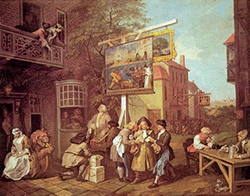
- Canvassing for Votes
- Hogarth, Canvassing for Votes (1757, Sir John Soane’s Museum): the country elector in front of the inn of a market town, having to choose between two parties, members of both attempting to obtain his vote by bribery.
[click on the picture to enlarge it].
d. The rise of the cabinet
Ministers had a leading role, and, though the title of ‘’Prime Minister’’ did not exist as yet, the function of chief minister was emerging: Sir Robert Walpole, who dominated politics from 1721, was the most influential politician of the age (died in 1745); he established the practice of living at 10 Downing Street in London (close to Parliament) which is still now the official residence of Prime Ministers. The world of politics was bitterly satirised for its corruption, for instance in Gay’s Beggar’s Opera (1728) where the highwayman is in fact a portait of Walpole. Public opinion was also informed by libels and cartoons – see Hogarth’s painting, which was circulated in prints.
e. The ‘’mob’’ .
The ‘’lower orders’’ of the population did not vote, but sometimes erupted into public life in riots – the ‘’mob’’ (=latin mobile vulgus, the unstable multitude), especially against certain religious or political groups. Such riots obliged Parliament to withdraw the act allowing Jews to be naturalized (1753-54), and the ’’Gordon riots’’ caused deaths and destructions in protest against the act allowing Catholics to enter public employment, from which they were previously barred (1780) ; in Birmingham, a mob destroyed the house of the scientist Priestley, who was suspected of being sympathetic to the French Revolution, and who was a religious non-conformist (1791).
2. The ‘‘three kingdoms’’
The three kingdoms were England, Scotland and Ireland.
a. England is where the seat of government was, in London.
b. Scotland , whose reigning dynasty (the Stuarts) had also ruled England from 1603, ceased to have a separate Parliament by the Act of Union (1707); Scottish electors then sent MPs to the Westminster Parliament in London, and laws applying to Scotland were passed by the Westminster Parliament. One of the reasons for developing the new neoclassical area of Edinburgh called ‘’the New Town’’ in the second part of the 18th century was the desire to retain the Scottish governing classes of society in Scotland by offering them splendid attractive housing in Edinburgh, and stop them moving to London to be near the centre of government.
Here again, the urban development is linked to the political evolution.
c. Ireland : the same procedure was taken for Ireland in 1800 by another Act of Union.
3. Country and city
a. The population grew from about 5 million in 1700 to nearly 9 million in 1800. The majority lived in the country; it was later, in the mid 19th century, that the urban population overtook the rural population. Some of the inhabitants were foreigners, for instance the Huguenot silversmiths, in areas of East London where the houses that they decorated have survived, together with their place of worship later turned to other uses.
b. The electroral system
The limits of ‘’constituencies’’ (areas that return an MP – Member of Parliament) were established in the Middle Ages, and had not been adapted to reflect changes in the population. Places that were important in the Middle Ages, but where the population had almost totally vanished, were still represented in Parliament, so that ‘’rotten boroughs’’ as they were called, which could then be villages of three electors, had an MP. On the contrary, former villages that had grown to be important industrial towns like Manchester (see chapter of Georgian Cities in Urban Growth section) were not represented in Parliament because they were new. The distribution of constituencies remained unchanged till Earl Grey initiated the electoral reform of 1832, which gave parliamentary representation to the new industrial areas. Political representation was slow in following the urban development.
c. Country and city estates
Landed families that owned vast estates in the country also developed areas in cities, so that names from their country estates were given to the new streets; see the page on the London estates of the Dukes of Bedford The urban development reflects the pattern of influence of landed families if you interpret street layout and street names.
4. International relations
a. In Europe
Britain was part of a European network of events and circulation of news: gazettes and newspapers would publish news coming from all countries. A significant event was the Lisbon earthquake, on 1 November 1755: the news reached the Paris gazettes and the London newspapers on 22 November, and it had European-wide consequences. Britain, a trading partner of Portugal, was affected. Sovereigns, including George II, sent funds for relief; and thinkers questioned the relation between the natural causes of disasters and divine intervention: the Protestant John Wesley saw the earthquake as a divine punishment for Catholic Spain’s practice of the Inquisition (Serious Thoughts Occasioned by the Earthquake at Lisbon, 1755), but others started doubting about providential designs. The news impressed the population all the more as there had been light earthquakes in London in 1750, causing fright in the population that attempted to flee the city.
Britain became one of the leading powers, and played a game of balance between continental countries, by diplomacy and by taking part in wars. Handel’s Dettingen Te Deum (1743) was composed to celebrate a victory of the British and Hanoverian troops, with their Austrian allies, over the French, in the War of the Austrian Succession.
For the benefit of the public attending concert halls, such musical compositions reflect current affairs
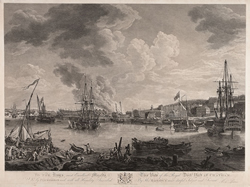
- Chatham – Dockyards
- Engraving (1793) after painting by Richard Paton (mid 1770s, Royal Collection)
[click on the picture to enlarge it].
b. In the world
The rising power of Britain over the oceans was celebrated in the hymn Rule Britannia, rule the waves (1740). Britain acquired India and Canada from France as a result of the Treaty of Paris ending the Seven Years’ War (1763), and discovered Australia, but lost the thirteen American colonies with the independence of the United States (1783).
This meant the development of the navy and of a particular type of urban design: the dockyards.
5. The economy
a. Agriculture
It was a significant part of the economy, both agriculture and cattle-raising ; it took place in large country estates, and new agricultural methods were experimented, such as the rotation of crops.
b. Industry and technology
An industrial system with work taking place in large factories started in the textile industry in the Midlands, where machinery such as the spinning machine was introduced in the 1760s; factories with a form of division of labour in several rooms was also introduced in the ceramics industry. Industries were supported by technical inventions or improvements such as Watt’s steam engine (1770s) in Birmingham.
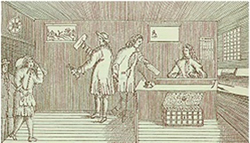
- The Bank of England (late 17th century engraving)
- [click on the picture to enlarge it].
c. Finance developed
The Bank of England was founded in 1694 to act as banker to the government during the war of the Grand Alliance; and the Bank of Scotland was founded in 1695 to support the development of trade.
This has to be seen against an international background - the rise of what would later be known as “central banks”, and which were very rare at the time.
First the governments of a few powerful cities were associated with public banks, Venice with the Banco della Piazza di Rialto founded in 1587 and Amsterdam with the Bank of Amsterdam founded in 1609: they were both important trading cities which needed to be supported by financial institutions. Countries followed: the Swedish “Bank of the Estates of the Realm” (Riksens Ständers Bank) was founded in 1668, thus being the world’s first central bank of a country, then the Bank of England in 1694 being the second one, and the Bank of Scotland in 1695. Later were the Spanish Banco Nacional de San Carlos (1782) founded to foster the economy and to manage the public debt; and the Banque de France (1800) meant to support the economy and to issue banknotes.
Lloyd’s insurers, especially active in maritime insurance, date from the late 17th century as well. Speculation caused a disaster ‘’The South Sea Bubble’’ in 1720, but the financial system recovered. Cities became financial centres.
d. Trade
Harbours traded with Europe, both exporting products from Britain such as textiles and manufactured goods, and importing metals and local productions or agricultural products, together with materials coming via other European ports from more distant countries. There were harbours both on the Eastern coast on the North Sea and on the Western coast. They traded towards the North Sea and the Baltic, or South towards the Atlantic and Mediterranean. They also traded with other parts of the world: Asia (the East India Company), Africa and America: there was an interest in exotic countries. The ‘’triangular trade’’ of the ports of the Western coast of Britain (selling goods in Africa in exchange for slaves and conveying them to America, then bringing back home American goods) came under criticism with the ‘’anti-slavery’’ movement in the second half of the 18th century, which led campaigns, and the abolition of the slave trade was decreed in 1807.
e. Transport
Inland, engineers established a network of canals to link the industrial areas and cities together, and to their trade outlets.
Journeys across the Atlantic and towards the Indian Ocean and the Pacific required navigational skills and technologies which improved during the century.
Technological and scientific progress led to new urban developments of commercial cities.

